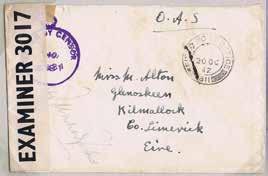
3 minute read
British Field Post Offices in the Faroe Islands during WW2

The mini-sheet illustrates a photo of the military post office in Miðvágur and a pencil drawing of the military post office in Tórshavn made by well-known Faroese artist Ingálvur av Reyni. The three FPO cancellations (611, 695 and 219) which were used by the British on the Faroe Islands during WW2 are also illustrated on the mini-sheet.
Advertisement
On the left of the sheet, you see the Lovat Scouts who served on the Faroes as an infantry unit from 25 May 1940 until 10 June 42. Below the Lovat Souts you see unidentified Royal Air Force (RAF) Personnel from the RDF (Radar) station at Eiðiskollur. Eiðiskollur was one of the five radar stations manned by the RAF on the Faroes in WW2.
An Unidentified Soldier of the Lovat Scouts is pictured on the right side. The bag on his chest held his respirator (‘gas mask’). And below you see the photo of Captain NMF Corbett, Royal Navy. He was the Naval Officer in Charge and Fortress Commander Faroe Islands from November 1941 until March 1945. He was also the senior British officer on the Faroes.

A troop of Lovat Scouts led by their regimental pipe band marching through Tórshavn.
Photo: National Museum, Denmark.

Envelope endorsed "O.A.S." (On Active Service) and cancelled with Field Post Office 611 (type 2) dated 20 October 1942. Censored with "P.C.90-3017" and "4381". Sent to Eire and it is not common.
Envelope owned by Steen Jack Petersen.
The third and final FPO that operated in the Faroes was number 695. This was allocated for use on 13th March 1943 and employed in Tórshavn until September 1945 when the last of the regular Garrison left the islands. (A small detachment of Royal Navy and then RAF personnel continued to man the LORAN station that had been erected at Skúvanes on Suðuroy until the end of 1946 when Danish naval personnel fully took over its operation). FPO 695 was clearly a replacement for FPO 219 but the reason behind this change is unclear and there was a period of several months when use of their cancellers overlapped.
Recent research in the Faroes has led not only to the identification of where the FPOs were located but also the discovery of some near contemporary photographs of the buildings they occupied. The one in Tórshavn was in the basement Tinghúsvegur 45 (nowadays renumbered to be 49). This was the home of Hans Joensen (Hansemann) and family and they continued to live in the upper storeys of the house. The 35KR stamp shows a pencil drawing of this house made by the well-known Faroese artist Ingálvur av Reyni.

Three servicemen who all worked in the Garrison Adjutant’s office in Torshavn. Sgt. Kenneth Williamson in the centre. On the left Sgt. Evans and on the right Cpl. Skarn. Williamson was in the Royal Engineers, Evans and Skarn were both in the Royal Army Service Corps.
Photo: Brian Hague.
The building occupied by the Miðvágur FPO had been built in the 1930s and its present day address is Bótalsvegur 11. The Hansen family who had lived there, moved to Leirvík after the property was requisitioned by the British military. An image of the property has formed the basis of the design of the 20KR stamp.
What about the personnel who worked in the FPOs? Surprisingly we can identify one of those who wielded the FPO 219 canceller on military mail leaving the islands. He was an NCO in the Royal Engineers, Sergeant Kenneth Williamson who, in correspondence after the war with a leading early collector of Faroese philately and postal history, confirmed that this was amongst his duties from his arrival in the Faroes in September 1941 until sometime the following year. However much Williamson appreciated that duty he certainly enjoyed his posting to the islands, researching their natural history and culture in his spare time and also meeting his future wife there, becoming one of the several British servicemen who married local girls. Williamson’s wedding to Esther Rein, took place in the Church of Tórshavn on 14th March 1944.
On his return to Britain after the war, Williamson wrote “The Atlantic Islands: The Faeroe Life and Scene”, which was published by Collins in 1948 and which was for many years the definitive English text on the islands.
Brian Hague





